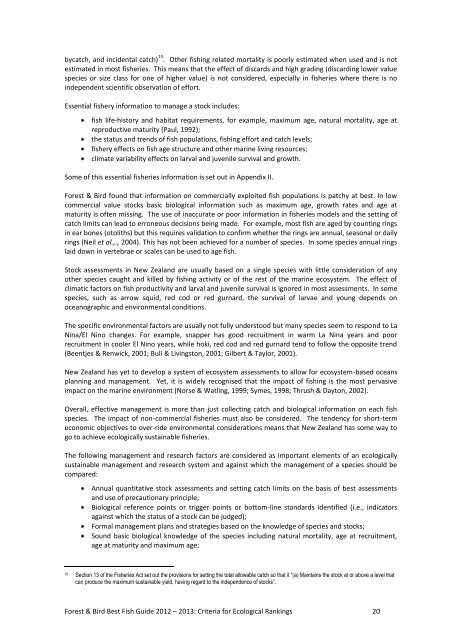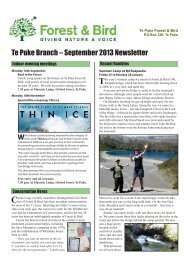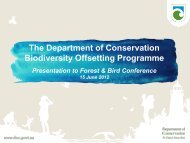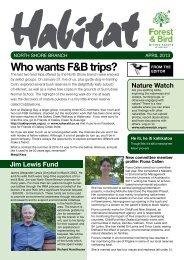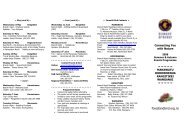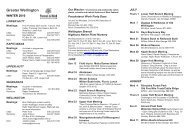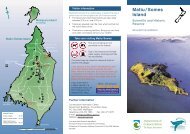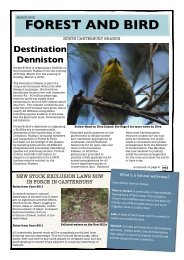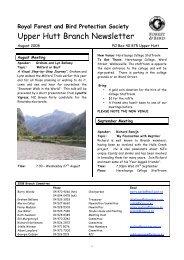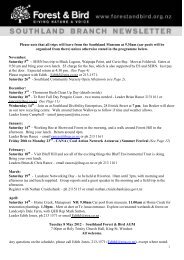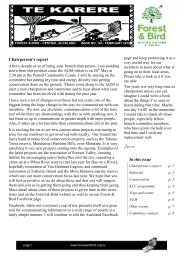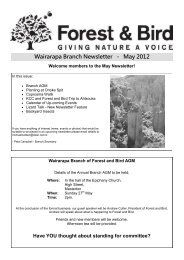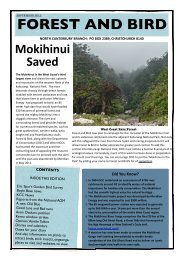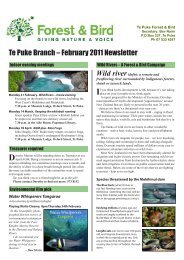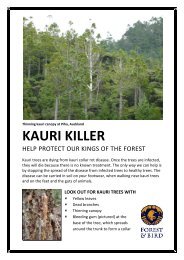methodology - Forest and Bird
methodology - Forest and Bird
methodology - Forest and Bird
Create successful ePaper yourself
Turn your PDF publications into a flip-book with our unique Google optimized e-Paper software.
ycatch, <strong>and</strong> incidental catch) 15 . Other fishing related mortality is poorly estimated when used <strong>and</strong> is not<br />
estimated in most fisheries. This means that the effect of discards <strong>and</strong> high grading (discarding lower value<br />
species or size class for one of higher value) is not considered, especially in fisheries where there is no<br />
independent scientific observation of effort.<br />
Essential fishery information to manage a stock includes:<br />
fish life-history <strong>and</strong> habitat requirements, for example, maximum age, natural mortality, age at<br />
reproductive maturity (Paul, 1992);<br />
the status <strong>and</strong> trends of fish populations, fishing effort <strong>and</strong> catch levels;<br />
fishery effects on fish age structure <strong>and</strong> other marine living resources;<br />
climate variability effects on larval <strong>and</strong> juvenile survival <strong>and</strong> growth.<br />
Some of this essential fisheries information is set out in Appendix II.<br />
<strong>Forest</strong> & <strong>Bird</strong> found that information on commercially exploited fish populations is patchy at best. In low<br />
commercial value stocks basic biological information such as maximum age, growth rates <strong>and</strong> age at<br />
maturity is often missing. The use of inaccurate or poor information in fisheries models <strong>and</strong> the setting of<br />
catch limits can lead to erroneous decisions being made. For example, most fish are aged by counting rings<br />
in ear bones (otoliths) but this requires validation to confirm whether the rings are annual, seasonal or daily<br />
rings (Neil et al.,., 2004). This has not been achieved for a number of species. In some species annual rings<br />
laid down in vertebrae or scales can be used to age fish.<br />
Stock assessments in New Zeal<strong>and</strong> are usually based on a single species with little consideration of any<br />
other species caught <strong>and</strong> killed by fishing activity or of the rest of the marine ecosystem. The effect of<br />
climatic factors on fish productivity <strong>and</strong> larval <strong>and</strong> juvenile survival is ignored in most assessments. In some<br />
species, such as arrow squid, red cod or red gurnard, the survival of larvae <strong>and</strong> young depends on<br />
oceanographic <strong>and</strong> environmental conditions.<br />
The specific environmental factors are usually not fully understood but many species seem to respond to La<br />
Nina/El Nino changes. For example, snapper has good recruitment in warm La Nina years <strong>and</strong> poor<br />
recruitment in cooler El Nino years, while hoki, red cod <strong>and</strong> red gurnard tend to follow the opposite trend<br />
(Beentjes & Renwick, 2001; Bull & Livingston, 2001; Gilbert & Taylor, 2001).<br />
New Zeal<strong>and</strong> has yet to develop a system of ecosystem assessments to allow for ecosystem-based oceans<br />
planning <strong>and</strong> management. Yet, it is widely recognised that the impact of fishing is the most pervasive<br />
impact on the marine environment (Norse & Watling, 1999; Symes, 1998; Thrush & Dayton, 2002).<br />
Overall, effective management is more than just collecting catch <strong>and</strong> biological information on each fish<br />
species. The impact of non-commercial fisheries must also be considered. The tendency for short-term<br />
economic objectives to over-ride environmental considerations means that New Zeal<strong>and</strong> has some way to<br />
go to achieve ecologically sustainable fisheries.<br />
The following management <strong>and</strong> research factors are considered as important elements of an ecologically<br />
sustainable management <strong>and</strong> research system <strong>and</strong> against which the management of a species should be<br />
compared:<br />
Annual quantitative stock assessments <strong>and</strong> setting catch limits on the basis of best assessments<br />
<strong>and</strong> use of precautionary principle;<br />
Biological reference points or trigger points or bottom-line st<strong>and</strong>ards identified (i.e., indicators<br />
against which the status of a stock can be judged);<br />
Formal management plans <strong>and</strong> strategies based on the knowledge of species <strong>and</strong> stocks;<br />
Sound basic biological knowledge of the species including natural mortality, age at recruitment,<br />
age at maturity <strong>and</strong> maximum age;<br />
15 Section 13 of the Fisheries Act set out the provisions for setting the total allowable catch so that it ―(a) Maintains the stock at or above a level that<br />
can produce the maximum sustainable yield, having regard to the independence of stocks‖.<br />
<strong>Forest</strong> & <strong>Bird</strong> Best Fish Guide 2012 – 2013: Criteria for Ecological Rankings 20


